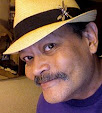Maureen Thorson’s NaPoWriMo prompt: “[R]ead Robert Hillyer’s poem, Fog. It uses both rhyme and uneven line lengths to create a slow, off-kilter rhythm that heightens the poem’s overall ominousness. Today we’d like to challenge you to try writing a poem of your own that uses rhyme, but without adhering to specific line lengths. For extra credit, reference a very specific sound, like the buoy in Hillyer’s poem.”
Robert Lee Brewer’s Poem-a-Day prompt: “[W]rite an ekphrastic poem. An ekphrastic poem is a poem inspired by another piece of art, whether that's a painting, photograph, sculpture, mixed media, or some other medium.” Brewer provided several examples of artwork for ekphrasis. Here is the one I chose to write on.
Here's the poem, merging both prompts. To satisfy the NaPoWriMo prompts, it's a sonnet with lines of varying length, rhymed Shakespearean style. In response to the Poem-a-Day prompt, it's an ekphrastic poem as well as a concrete poem!
Uneven Sonnet
—after Unwavering
by Martin Klein
My hair blows sideways
in the harsh wind unwavering
always.
My shoulders bear the layering
weight of my tattered clothes, windstorm torn and shredded,
blades of seaweed bared in a hurricane
and stretched out, wedded
to the typhoon’s locomotive, the long train
of buffeting air behind.
I stand, also unwavering, daring the gale
to blast its hardest derecho wind.
I am still,
a pillar
a boulder.
—Draft by Vince Gotera [Do not copy or quote . . . thanks.]
Alan's poem today also merges both prompts . . . an ekphrastic poem with rhyming couplets of varying line lengths.
The Wound
After Thomas Hart Benton,
The Ballad of the Jealous Lover
of Lone Green Valley (1934)
The image winds.
One finds
a spiral from the bottom left
that carves a cleft
between the man blowing harp
and the fiddler, whose sharp
fingers look like claws
as he draws
his bow across the fiddle’s strings,
and a young man as he sings,
his vacant stare
into some space before him, a glare
at violence he’s describing
in his verses, which makes us wonder what the trio is imbibing
from the corked jug
and the two mugs on the table (where’s the missing mug?).
These corner atmospherics
distract us for a moment from the image that the lyrics
are conjuring, how a jealous lover,
knife in hand, still seems to hover
over
one he thought he had possessed
as she presses her breast
from which he’s pulled his bloody knife.
Is she his wife
or fiancée?
Who can say?
Could she have violated vows
to cheat on an unwitting spouse?
It doesn’t matter. Everything’s so out of kilter
that it’s difficult to filter
out conventional murder ballad morality semi-justifying
how the lover watches her dying;
the landscape doesn’t make any sense—
the kneeling cow’s outside the fence,
there’s stumps left in the furrowed field,
the sinking sun can barely wield
from its own furrow light to backlight
what’s not even been a fight
but an unexpected mortal wound
that does not make a sound
because the action’s in the corner,
where the trio can’t think of anything forlorner
than a barefoot woman, a broganned man,
the starting of a rhododendron hell,
and an old-time ballad meant to tell
about deceit,
the sweet
belief in having been loved by someone dear,
the bitter sorrow once it’s clear
that when somebody wants you body and soul,
it’s the soul they’re after, never you whole.
—Draft by Thomas Alan Holmes [Do not copy or quote . . . thanks.]
Thomas Hart Benton,
The Ballad of the
Jealous Lover
of Lone Green Valley (1934)
|
Friends, won’t you comment, please? Love to know what you’re thinking. Thanks!
Ingat, everyone. ヅ |







1 comment:
This is great, Vince. I love the language of the sonnet, and the sculpture too. You seem to replicate it with uneven lines "blowing out" from the left margin.
Post a Comment